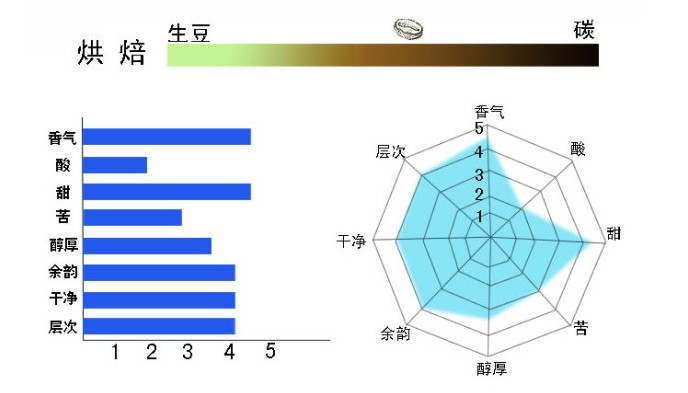Yemeni mocha single coffee
In fact, the word mocha comes from the southwest of the Asian continent, the southwest end of the Arabian Peninsula, and a port across the sea from Africa. Mocha Port now belongs to the Republic of Yemen, one of the poorest countries in the world. The mocha coffee here is regarded as a treasure by coffee lovers all over the world. It can be encountered but not sought. If you claim to love coffee but have never tasted authentic Yemeni mocha coffee, it cannot be regarded as the biggest regret of coffee lovers.
A long time ago, Ethiopians ruled Yemen today and transplanted coffee to Yemen. Later, Arabs ruled the entire Arabian Peninsula, Yemen was also among them. Natural energy coffee also became an Arab drink. In order to monopolize coffee, the export of coffee beans had to be scalded to prevent it from germinating. At that time, the port of coffee export was Mocha Port, so the name of Mocha coffee has been handed down to this day.
Due to the arid environment in Yemen and the lack of water for coffee treatment, Yemen's coffee treatment is all sun treatment, which retains the fruit flavor of coffee to the maximum extent, but also causes certain miscellaneous flavor, which may eventually cause instability in quality. Yemeni mocha coffee has a strong cocoa flavor, a fermented smell similar to red wine, a light fruit aroma, a taste of milk chocolate, and a moderate alcohol content. However, due to the poverty and harsh climate in Yemen, the production of authentic mocha coffee is getting less and less, so the good mocha coffee is expensive.
It is difficult for Americans to forget the taste of mocha coffee after drinking mocha coffee at first, but when mocha coffee is gradually reduced, in order to let people remember the taste of mocha coffee, chocolate or chocolate sauce is added to the coffee to express the milk chocolate taste of mocha, but in fact, fancy mocha coffee has no connection with the real single mocha coffee.
Common Yemen mocha coffee means Mattari, Sananni In fact, Mattari is the most common name of Yemen mocha. At first, this only refers to coffee produced in Bani Matar, with high acidity, but now coffee beans from many other regions are mixed with coffee beans here for export to obtain better prices, which also affects the quality stability of Mattari, while Sanani is mainly produced in the west of Yemen's capital Sana 'a. Sanani coffee has soft acidity, good taste uniformity and moderate alcohol.
Mocca Sanani is produced in the surrounding area of Sana'a. Due to the full sun treatment, the coffee quality is not very good. The green beans are pale yellow and slightly pale green. Since the Ethiopian coffee was introduced, Yemen coffee has been mixed with Arabica original coffee. The beans are small, the uniformity is poor, and the defect rate is high. It needs to be carefully selected before roasting. Since Yemen is a very poor country, the coffee produced locally is also organic coffee.

Yemeni coffee in the taste of my personal preference, after testing, we choose light roast, ground dry aroma with hay flavor, later will appear fresh fruit aroma, very light, but completely different from the previous dry aroma, so it is easy to find. When full, the moist aroma has hints of peanuts and nuts. It tastes bitter, but it immediately turns to a sweet taste similar to milk chocolate. The lower the temperature, the more obvious the taste. It was very similar to the faint fruit fragrance of wine. The cocoa smell appeared at the back end. The alcohol was moderate. Although it was sun-baked coffee, it tasted no worse than washed coffee after drinking.
If you use a short word to describe this mocha coffee, I would say that this is the authentic coffee taste, inherited the traditional at the same time, there is no lack of fresh and elegant, definitely as a coffee lover you can not miss a good coffee.

Important Notice :
前街咖啡 FrontStreet Coffee has moved to new addredd:
FrontStreet Coffee Address: 315,Donghua East Road,GuangZhou
Tel:020 38364473
- Prev

Correct Preservation method of Coffee Bean
The raw beans stored in sacks are very similar to people in many places, such as the storage environment, the comfortable environment is suitable for raw beans: dry, dry, cool, not hot or cold, the only exception is light. Raw beans should be protected from light. Raw beans are crops and need to breathe, so theoretically the best storage material is clean, odorless and breathable.
- Next

Yemeni Matari mocha of boutique coffee
Yemen is the first stop for the coffee variety Arabica to be transplanted from Ethiopia. Although the genetic polymorphism is impaired, it still retains a considerable number of multiple coffee genes, making it the second country in the world qualified to be crowned with ancient superior varieties. In addition, early Yemeni coffee was mainly exported from the port of Mocha, so the coffee that was later exported from here was named after Mocha.
Related
- Detailed explanation of Jadeite planting Land in Panamanian Jadeite Manor introduction to the grading system of Jadeite competitive bidding, Red bid, Green bid and Rose Summer
- Story of Coffee planting in Brenka region of Costa Rica Stonehenge Manor anaerobic heavy honey treatment of flavor mouth
- What's on the barrel of Blue Mountain Coffee beans?
- Can American coffee also pull flowers? How to use hot American style to pull out a good-looking pattern?
- Can you make a cold extract with coffee beans? What is the right proportion for cold-extracted coffee formula?
- Indonesian PWN Gold Mandrine Coffee Origin Features Flavor How to Chong? Mandolin coffee is American.
- A brief introduction to the flavor characteristics of Brazilian yellow bourbon coffee beans
- What is the effect of different water quality on the flavor of cold-extracted coffee? What kind of water is best for brewing coffee?
- Why do you think of Rose Summer whenever you mention Panamanian coffee?
- Introduction to the characteristics of authentic blue mountain coffee bean producing areas? What is the CIB Coffee Authority in Jamaica?

